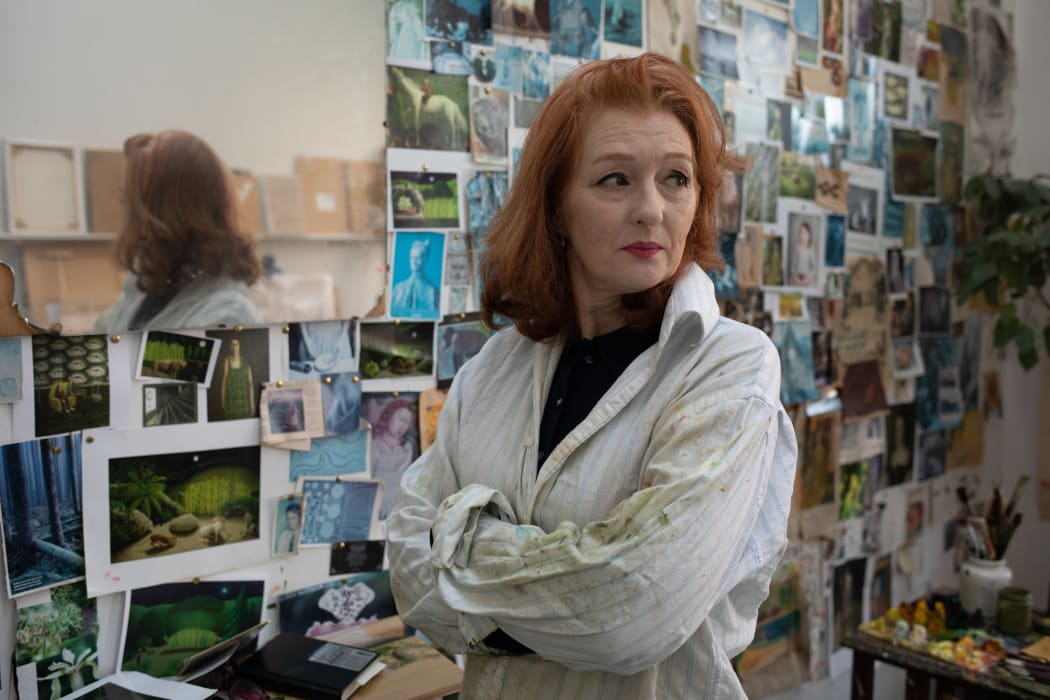
Each month, we’re sitting down with one of our Academicians to discuss their practice, influences and upcoming projects. Today, we’re speaking to Helen Flockhart RSA about the Garden of Eden, studying in Poland, and New Contemporaries.
Your paintings offer critical or reimagined perspectives on various mythological, historical, and biblical stories. Are there any myths, histories or biblical stories you find yourself returning to most often?
I guess the story which I have returned to most often over the last 40 years is the story of the Garden of Eden and its antecedents – other Eden myths have prevailed in different cultures back to the Sumerians via the Babylonians and Assyrians, and it pops up in Greek Myth in guise of the Garden of Hesperides.
I don’t know why I am drawn to painting a paradise. Maybe it has something to do with it affording the opportunity to immerse myself in that lushness of The Garden for the duration of the painting. I love plants and growing them, and my tiny garden is an attempt to create a space where I am enfolded in fecund abundance, with lots of contrasting leaf shapes and a myriad of green. The green paintings are an extension of that. Life is brief; summers are very brief in Scotland – why wouldn’t you want to press yourself up against that growth, and indeed life, while you can? I often conceive of my most lush compositions in the most barren months of winter when I crave saturated colour and am yearning for growth, so I suppose I try to create an Arcadia vicariously via my paintings.
There is something primal about the imagery and symbolism in the artworks on this subject throughout art history. They connect with me on an elemental level which is beyond intellect and reason and, having been brought up in an atheist household, that connection has nothing to do with any inculcated faith. At the same time, the format of a Garden provides a perfect stage on which to create and explore the relationships between the characters I place therein, and to muse on the attitudes which have attached themselves to those players and what this tells us about ourselves both now and in the past.
The first painting I painted which could be said to be related to this theme was for my degree show in 1984, and since then I’ve returned to it periodically right up until a couple of months ago when I finished Green Eden, as yet unexhibited.
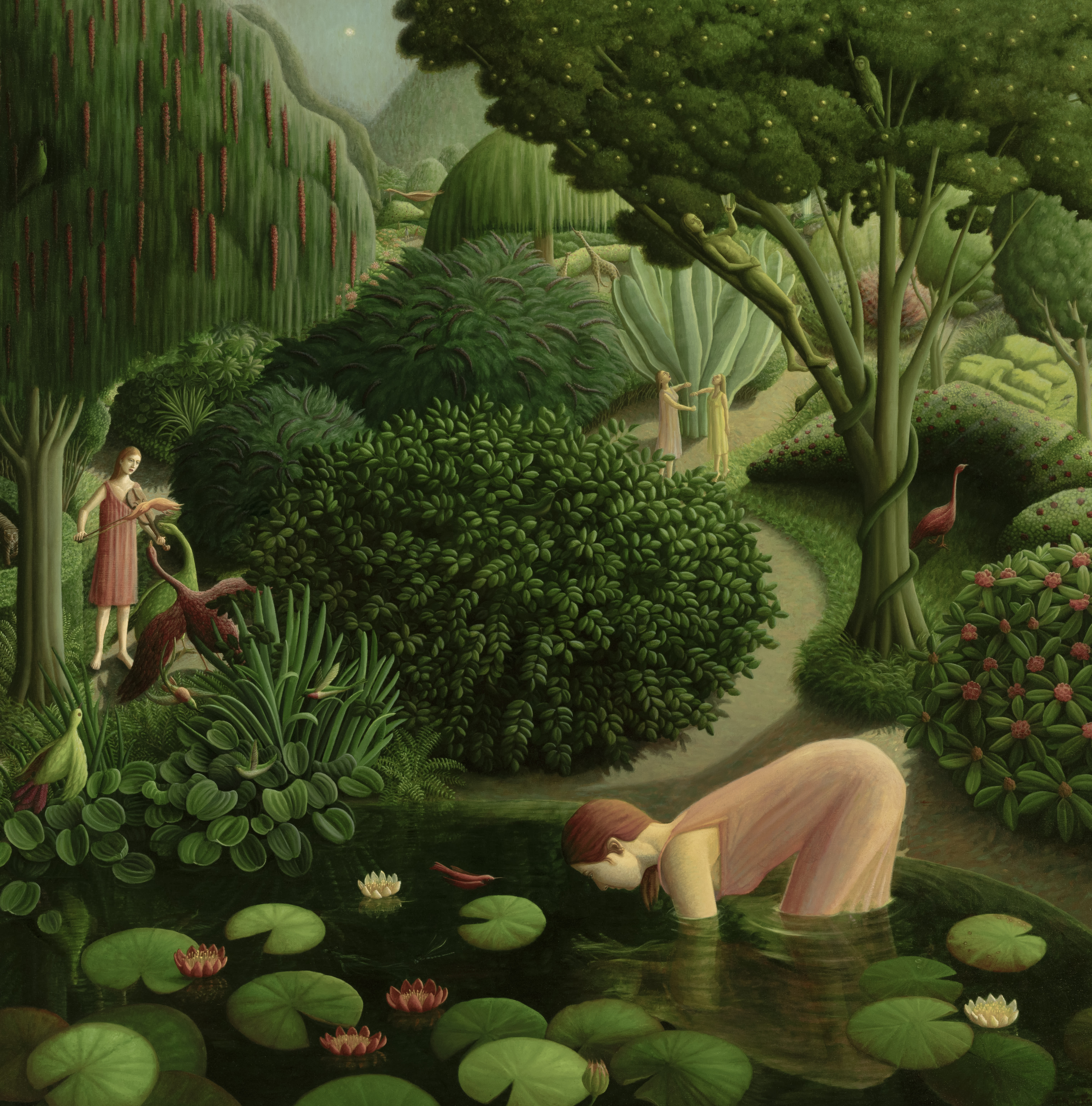
Helen Flockhart RSA, Garden of Hesperides, oil on linen
Female figures often appear in your paintings, and you’ve previously described your art as 'unashamedly feminine'. What role do you feel femininity plays in your work?
When I first read this question my immediate response was 'Did I say that? Ouch!' It’s always confronting being presented with something you might have said 10 years ago.
Of course I did say it. I think this was in the context of a discussion about the most successful painters to come out of Glasgow in the mid-1980s who were mostly male, and of the paintings I was producing 10 years ago which had a lot of rendered lacework, beadwork and textural flower-clustered backgrounds. I was incorporating repeat patterns of, for example, vulval symbols, plants redolent of spermatozoa or fruits imbued with sexual metaphor.
Traditionally we associate the production of embroidery, appliqué, beadwork etc with women and call these ‘crafts,’ and they are regarded as lesser, but for centuries they provided an outlet of creativity at a time when women were not being commissioned to produce marble sculptures for Popes and didn’t have the education, status or connections to paint for rich patrons. As I was to learn when researching for my show inspired by the life of Mary Queen of Scots in 2018, Mary herself produced many embroideries during her years of incarceration, within which she would smuggle covert hints at her plight, such as feelings of being toyed with by her jailer, Elizabeth I (interestingly her grandfather, James IV, was also a skilful embroiderer). I guess my objective was to employ those vehicles of expression traditionally considered feminine and produce something dynamic which asserts my relationship to the world. In a way, they were both of the female and manipulated perceived femininity.
I’ve developed a way of working over the years within which I can express myself using skills which are peculiar to me and drawing on subjects and imagery which resonate with me. These can be intricately wrought pieces, and yes, female figures often, though not always, predominate. Do I have to give a reason for that? I don’t know. Are male artists asked to explain male-centricness in their paintings?
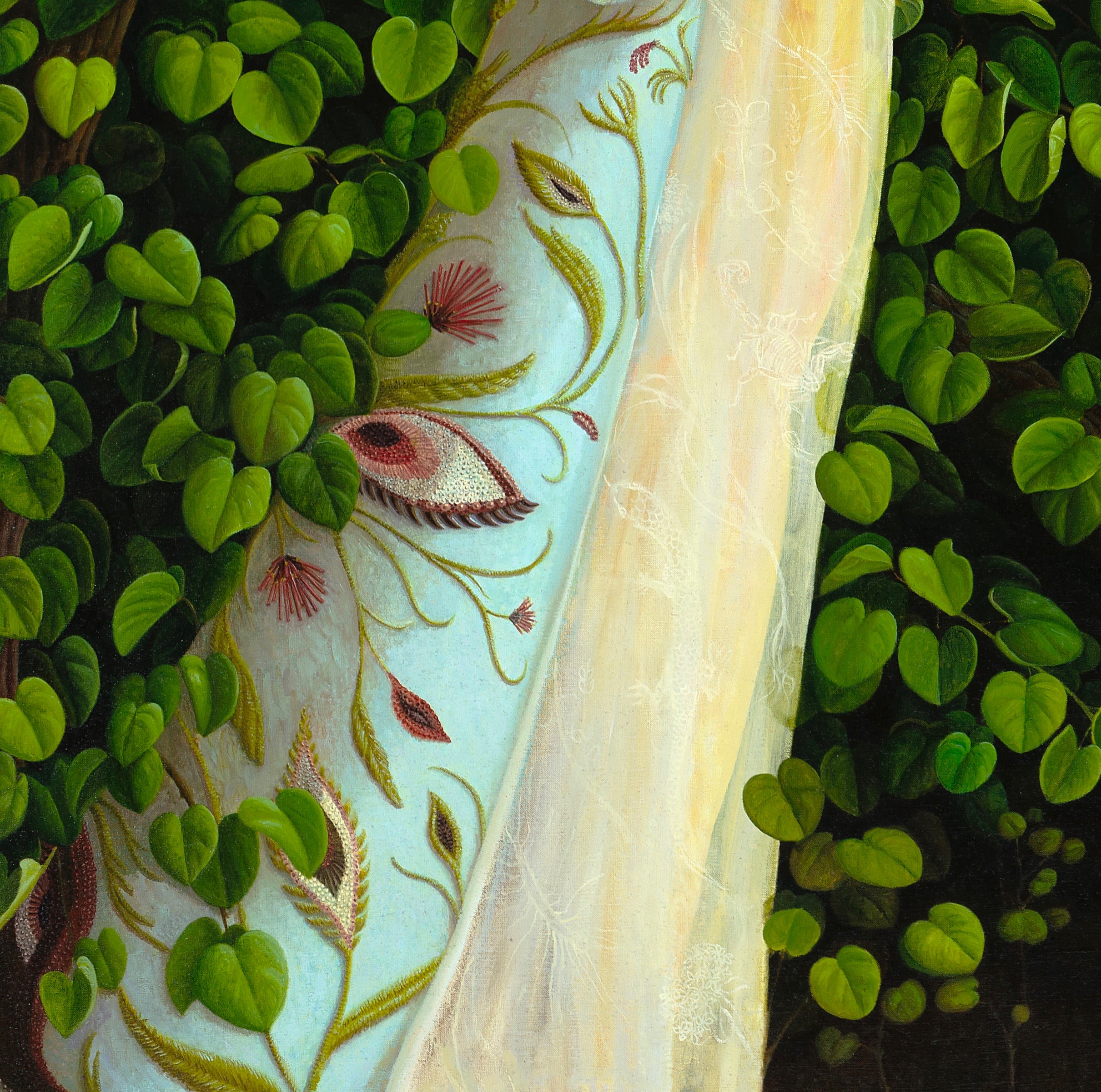
Helen Flockhart RSA, Asterion detail, oil on linen
After studying at Glasgow School of Art, you received a British Council Scholarship to study at the State Higher School of Fine Art in Poznan, Poland between 1985 and 1986. Could you tell us a bit about your time in Poznan and how it influenced your practice?
Poland was a fairly austere place in 1985. This was 4 years short of the fall of the Berlin Wall, Poland still had a Communist government, fresh in everybody’s memory was the Solidarność uprising and martial law a few years earlier, and the city was overlooked by an illuminated motivational sign urging citizens to work hard and relax well. At the same time, art and theatre was vibrant, there were jazz clubs, opulent churches, spectacular mountains in the south, friendship, generosity and a very dry, gallows humour.
Warsaw was quite international compared to Poznan, where I was. Few people spoke English in Poznan and I spent the first few days alone in my room eating only cake and drinking lemonade as this was all I could manage to buy by pointing and I was too timid to approach the meat cleaver-wielding women on the butcher counter or negotiate the ration card which had been thrust in my hand before being deposited at the Akademik. No other students were to arrive for a week. So I had to try to learn to speak Polish – at lessons at the university for the first 10 weeks and then just trying to pick it up.
There was a big difference between the kind of art being produced in the art school there and in Glasgow, which had been at the height of the New Figuration movement when I left. In Poland, there was a lot of abstract expressionism, installation-based work, performance art, happenings, innovative sculpture. So it was quite dislocating work-wise for a while.
Poznan was famous for its Gobelin (tapestry) department. Magdalena Abakanowicz was head of the department although she was on sabbatical when I was there – she was already, rightly, a superstar. I had seen her sculptures in the exhibition, Women’s Images of Men in the Third Eye Centre (later the CCA) in Glasgow in 1981. It was a powerful show and had woken me up to the potential of art to viscerally move something in me over and above what had hitherto been a preoccupation purely with representational painting. There were women producing extraordinary works in the Gobelin department. Beautiful textural things. They were way ahead of me conceptually and in their ability to articulate what they were doing, but there was a lot of warmth in that department. I vividly remember a candlelit gathering before Christmas where the dye bath was chock full of live carp. I have good memories. And my Danish roommate worked there.
It took a couple of years for what I had seen and experienced to percolate down. The paintings and sculptures I spent a lot of time looking at alone in churches and museums, from medieval icons onwards, definitely had an influence, eventually bubbling up into the first works which were the beginnings of my finding a voice post-art school, and there’s a direct line between that and what I went on to do.
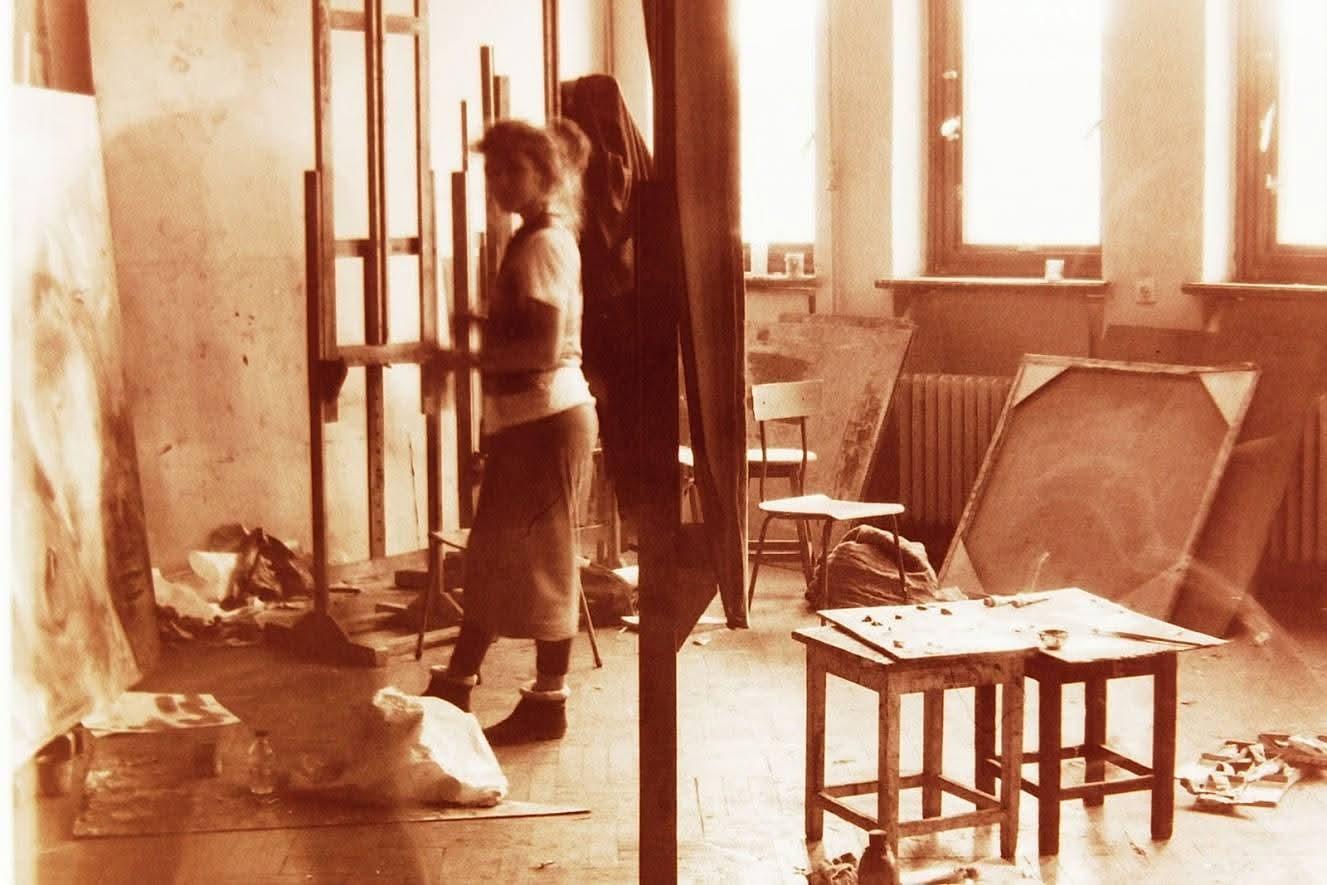
Helen Flockhart RSA in her studio in Poznan, 1986, credit Dariusz Glowacki
You were on the New Contemporaries Hanging Committee in 2024, and helped select graduates from the 2022 and 2023 degree shows. What was your experience of working on the exhibition, and how important is it to you to support the work of emerging artists
I’ve never taught, so it was a curious experience to be back in an art school on the other side. That cohort of students had had it tough as their time as undergraduates had spanned the Covid years, so their experience had been a world away from that of my generation, and there had anyway been big changes in art education since my day.
I was conscious of what an onerous responsibility selecting young people is. We are all in this business familiar with rejection and the seeming randomness of who succeeds and who doesn't, and I did have a conscience about being party to inflicting that rejection. But of course, it’s unavoidable and space is limited. It was good to be part of a team and to be part of the transition from complete chaos at the outset towards a coherent exhibition, and to witness how the hanging or installation of a piece can elevate it.
When artists or architects are elected as Academicians, they're asked to submit a Diploma Work to the RSA Collection. Could you tell us about your Diploma Work, Squid, and how you came to choose it as the work that would represent your practice?
Squid was my personal favourite from my last solo show and was the first in the series which I produced.
There is the pathos of the creature, sleek and powerful in his element; impotent in the dry domestic setting in which he finds himself, and the incongruity of his presence. He's not a malign presence and the figure is oblivious rather than threatened. I don’t know what’s going on through the red doorway, but there’s a sense of portent there.
I’d been thinking of the myth of Perseus slaying Cetus the sea monster and bearing away Andromeda from her native Ethiopia to an alien land as a trophy wife. Both can be seen as trophies, and both are victims of Perseus’ vanity – Andromeda displaced, Cetus slain. I like to take the myths and incorporate them within a setting other than that of their inception, be it contemporary or timeless – it helps me to be able to see them through a fresh lens, to look at what was actually happening rather than seeing a fossilized motif frozen in time which has no bearing on our lives in the here and now. Human behaviour, power dynamics and the consequences of war haven't changed much since the myths of the ancients, though our perception of what is moral may come and go and geopolitical power may shift. But we become so familiar with the stories in myth form that it's easy not to question who deserves to be the hero and who the monster. It's a bit like with nursery rhymes: we can catch ourselves trotting out a familiar rhyme to a tot and it dawns on us that we’re trilling about capital punishment, whipping children or sectarian killing.
This painting slipped out of me so easily and I like the simplicity of the composition. The colour was inspired by Frederick William Elwell’s The Wedding Dress. I went on to develop a whole show from this point, so I thought it was worth offering it as my diploma piece.
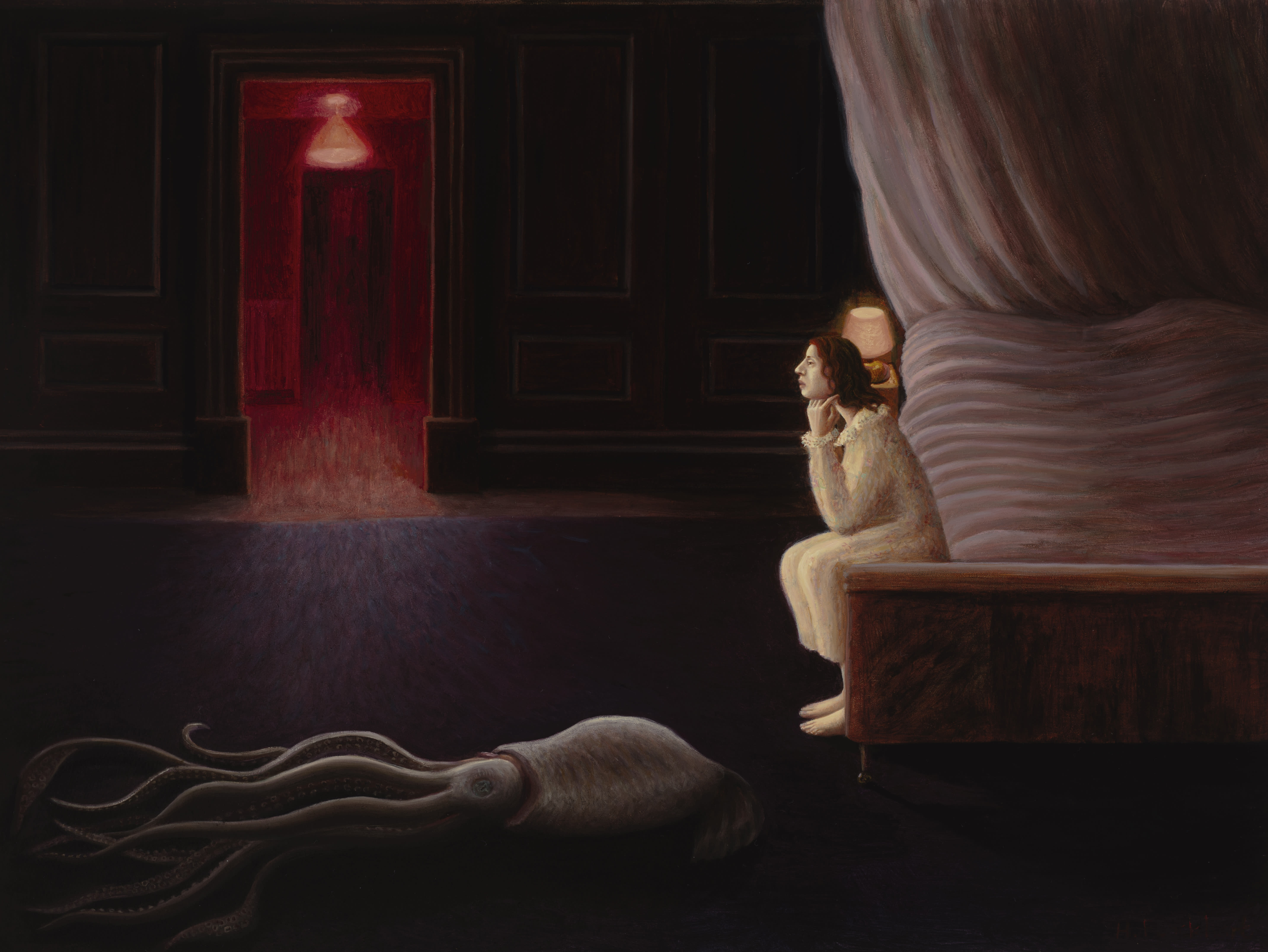
Helen Flockhart RSA, Squid, oil on panel. RSA Diploma Collection Deposit.
In your essay for Frontiers: Painting in Scotland Now, you discuss being 'wracked with self doubt' at the middle stages of a painting before you are able to reach 'the unique sensual pleasure' of having finished it. How do you navigate through this self-doubt to reach that feeling of pleasure from finishing a painting?
Just to be clear – the unique sensual pleasure is in the finishing off of it, not in it being finished. In the end stage all the donkey work is done: you know where everything is going, the underpainting has been built up, forms are reading and you can apply glazes, add depth to shadows and highlights to flesh tones, take pleasure in the application of juicy paint and work up some textures. It's at this point that the painting begins to sing and everything you do makes it better and adds lustre to the surface. This is a small fraction of the time spent on a painting though, and often as not the pleasure is marred by emails from a gallery asking when the painting will be ready as you’ve already spent too long on it and are feeling guilty about that.
It’s the middle stage, after the excitement of moving on to the canvas or panel and drawing out and blocking in, when I can be wracked with self doubt. Trouble is, I rarely have every square inch mapped out in my head as I could be scaling up a sketch which is 2cm x 3cm into a painting which is 4 ft x 6ft, so there won’t be much information to go on bar the bare bones. I’m chiselling it out and hoping there is something in there, so I just have to feel my way through it.
In the middle everything looks scrappy. Nothing pops, and it’s hard to know what should go in the empty areas because everything looks rubbish. There aren’t any shortcuts or hacks to get out of this situation, I just have to have faith it’ll work, use my instincts and refer back to the original sketch to be reminded what it was which excited me in the first place. Working up the areas I do know how to deal with does eventually suggest what I should do with the areas where I don’t. And surrounding myself with pictures which have elements which nod towards what I’m striving for, so that by the end of a painting the studio floor is covered in a mound of books open at particular pages with botanical plant drawings or animal illustrations, sketches, encyclopaedias, print outs of my own paintings or others’, or images which might have just an element of something which chimes, postcards, a splash of something of specific colour, a bit of fabric or a living plant, if I can get hold of one, which features in the painting to study its structure. The pile becomes increasingly messy as the painting progresses but I’m quite superstitious about not clearing it up until the painting is completely done. Basically, the answer is just to plough on and finish it, it’s as simple as that.
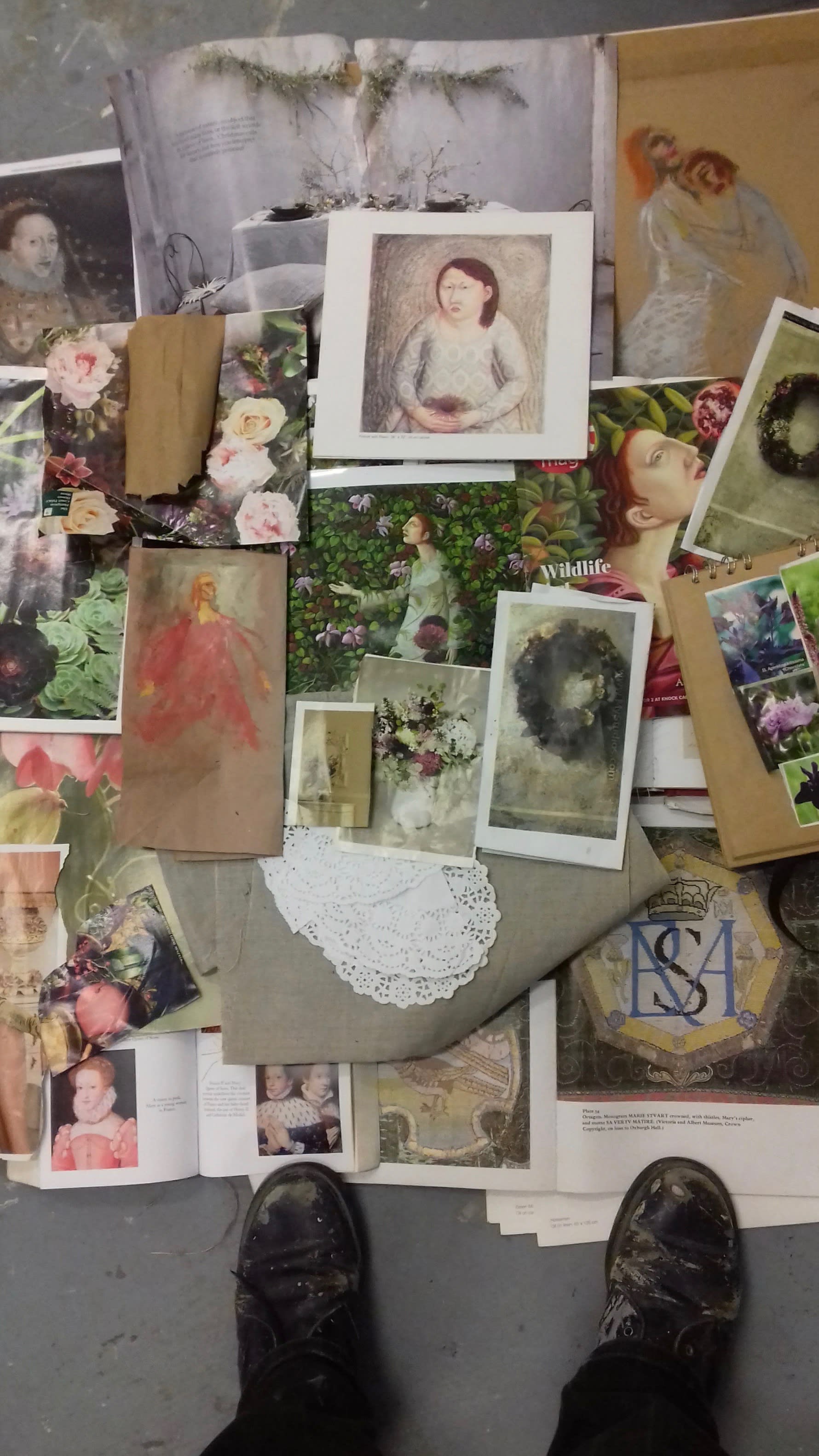
Helen Flockhart RSA in her studio, 2018
Explore Helen Flockhart RSA's work further

